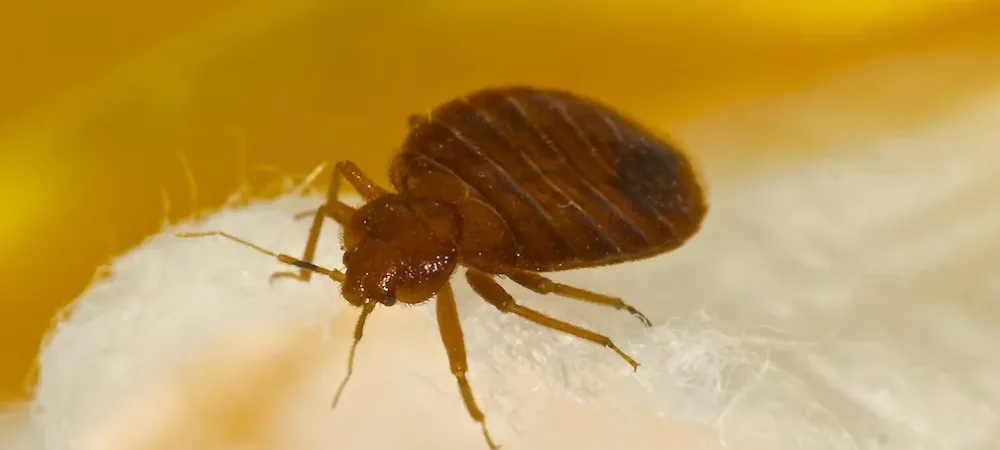Bed Bugs Pest Control Quiz

Goodnight, sleep tight and don’t let the bed bugs bite! Going to bed with these creepy crawlers on your mind can leave for many restless nights. At A&C Pest Management, we utilize a heat treatment that is a unique, environmentally sound process proven to get rid of these nightcrawlers lurking through your mattress.
We have given you ample information on what to look for if you suspect an infestation. Now, we put you to the test!
Bed Bug IQ Quiz
1.) What are bed bugs?
A. Small winged insects that belong to the family Cimicidae
B. Small wingless insects that belong to the order Acarina
C. The larvae of a type of mite of the family Trombiculidae
D. None of the above
2.) How big are adults?
A. 1-2 mm
B. 5-7 mm
C. ½ inch
D. ¾ inch
3.) What color are adults?
A. Light gray
B. Black
C. Reddish brown
D. White
4.) What color are nymphs?
A. White
B. Black
C. Brown
D. Clear
5.) Bed bugs can fly.
A.True
B. False
6.) Which factors may have led to a recent increase in infestations?
A. Restrictions on the use of stronger pesticides
B. Increases in immigration and travel from the developing world
C. A and B
D. None of the above
7.) Bed bugs need a blood meal at least once a week.
A. True
B. False
8.) They tend to be commonly found in:
A. Mattresses
B. Box springs
C. Furniture crevices
D. All of the above
9.) What are symptoms and signs of bites?
A. Raised bumps on the skin
B. Blisters on the skin
C. A spreading red rash
D. There are no symptoms and signs associated with bed bug bites
10.) What is the treatment for bites?
A. Typically, no treatment is required for bites.
B. Apply a pediculicide to the bite.
C. Place a cool compress over the bites.
D. An antivenin must be administered.
11.) How can people detect an infestation?
A. Identify fecal stains on the bed sheets.
B. Locate egg cases in crevices on or near the bed.
C. A and B
D. None of the above
12.) What is the best way rid of bed bugs in their home?
A. Put double-sided tape on cracks and crevices to trap them.
B. Wash infested surfaces with cider vinegar.
C. Use thermal remediation (heat treatment).
D. None of the above
13.) What’s the best way for people to prevent bed bug bites in hotels?
A. Search beds and mattresses for signs of an infestation.
B. Wear insect repellent when sleeping in a hotel bed.
C. Bring your own bedsheets.
D. None of the above
14.) Which of the following statements about bed bugs is false?
A. They may infest many units in an apartment.
B. They may be in suitcases that are moved from a hotel to home.
C. Bed bugs or their eggs may be present in used clothing.
D. None of the above
Answers
Score yourself and see how you did on our Bed Bug IQ Quiz!
1.) A
Small winged insects that belong to the family Cimicidae – Bed bugs are small, oval winged insects that belong to the insect family Cimicidae, which includes three species that bite people.
2.) B
5-7 mm – Adult bed bugs reach 5-7 mm in length, while nymphs (juveniles) are as small as 1.5 mm.
3.) C
Reddish brown – Adult bed bugs are reddish brown in color, appearing more reddish after feeding on a blood meal.
4.) D
Clear – Nymphs are clear in color and appear bright red after feeding.
5.) B
False – The wings of bed bugs are vestigial, so they cannot fly.
6.) C
A and B – Bed bugs were common in the U.S. before World War II and became rare after widespread use of the pesticide DDT began in the 1940s and 1950s. They remained prevalent in other areas of the world and, in recent years, have been increasingly observed again in the U.S. Increases in immigration and travel from the developing world as well as restrictions on the use of stronger pesticides may be factors that have led to the relatively recent increase in bed bug infestations.
7.) B
False – Bed bugs can live for months without feeding.
8.) D
All of the above – Bed bugs tend to be most common in areas where people sleep and generally concentrate in beds, including mattresses, box springs, and bed frames. Other sites where bed bugs often reside include curtains, the corners inside dressers and other furniture, cracks in wallpaper (particularly near the bed), and inside the spaces of wicker furniture.
9.) A
The bed bug bite itself is painless and is not noticed. Small, flat, or raised bumps on the skin are the most common sign; redness, swelling, and itching commonly occur.
10.) A
Typically, no treatment is required for bed bug bites. If itching is severe, steroid creams or oral antihistamines may be used for symptom relief. Secondary bacterial infections that develop over heavily scratched areas may require the use of antibiotics.
11.) C
A and B – You can look to see if you can identify the bed bugs’ fecal stains, egg cases, and exuviae (shed skins) in crevices and cracks on or near beds. You should also look at other areas such as under wallpaper, behind picture frames, in couches and other furniture, in bed springs and under mattresses, and even in articles of clothing.
12.) C
Thermal remediation, which uses intense heat to kill bed bugs, was developed as a safe, effective, and environmentally friendly alternative to chemical pest control applications. In response to changing government regulations, insect resistance to chemicals, and consumer preference for pesticide free products. This non-chemical, non-toxic approach penetrates wall cavities, mattresses and other hard to reach locations to kill bed bugs. Heat treatment works by applying high temperature evenly throughout a structure, killing bed bugs wherever they are hiding, something many other treatments cannot achieve in a single treatment. Thermal remediation will all of the growth stages of the bed bug including the eggs.
13.) A
Search beds and mattresses for signs of a bed bug infestation. – Those concerned about the potential for bed bugs bites in hotels should examine hotel beds and mattresses for signs of a bed bug infestation.
14.) D
None of the above – Bed bugs live in any articles of furniture, clothing, or bedding, so they or their eggs may be present in used furniture or clothing. They spread by crawling and may contaminate multiple rooms in a home or even multiple dwellings in apartment buildings. They may also be present in boxes, suitcases, or other goods that are moved from residence to residence or from a hotel to home.

